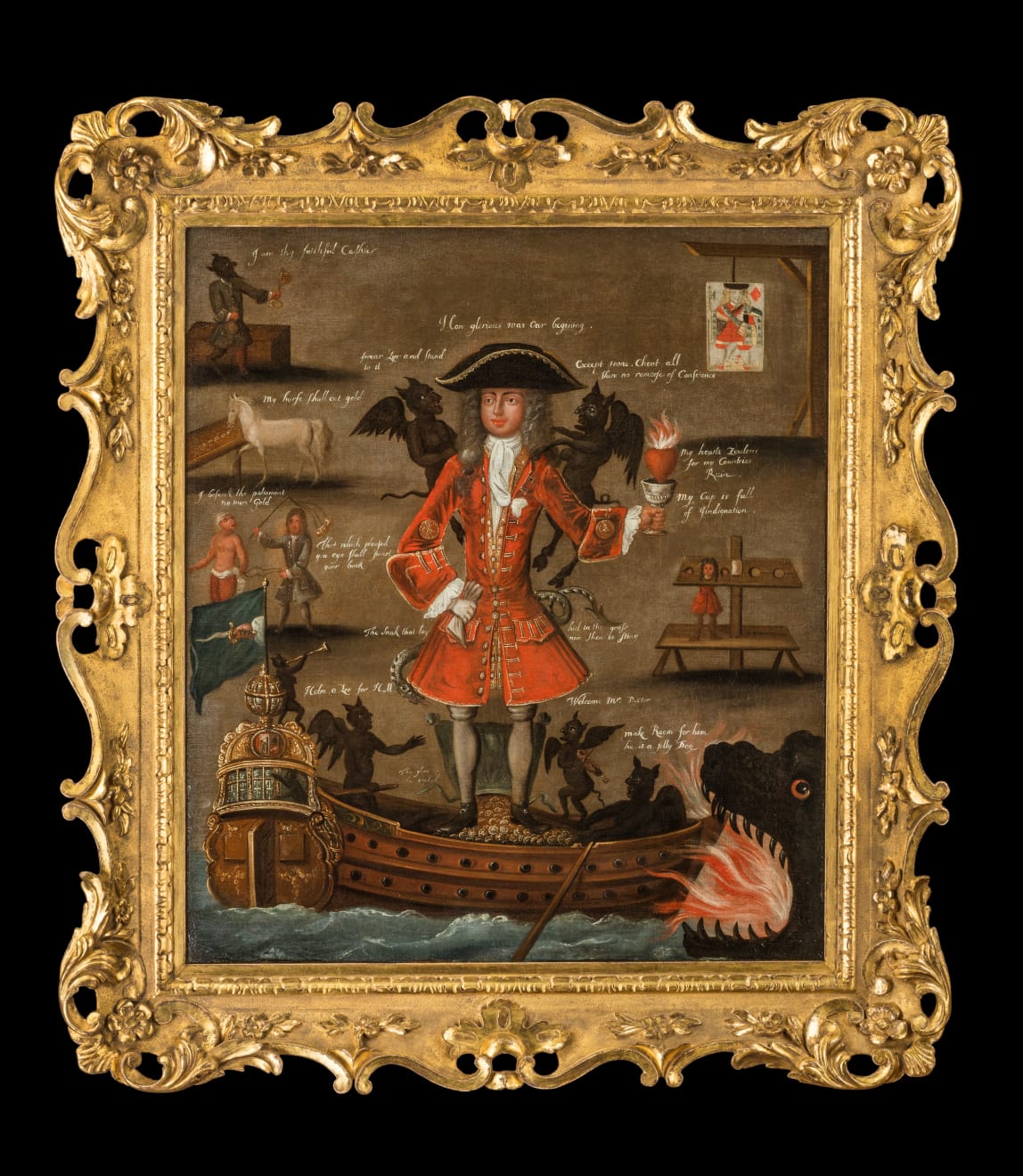ENGLISH SCHOOL/CIRCLE OF HOGARTH – Satirical portrait of Robert Knight, Cashier of the South Sea Company, or ‘Lucifer’s New Row-Barge’
71.8 x 62.5 cm
Further images
Provenance
From the collection of Sir Michael Codron.A satirical painting depicting Robert Knight, the Cashier of the South Sea Company, aboard a ship, from the stern of which flies a flag with a hand holding a flaming sword – the device of the ‘Sword Blade Company’. Two devils row the boat towards a black beast, symbolising Hell, whose gaping mouth emits flames. Two smaller devils are perched on the side and the stern of the boat: one playing a trumpet; the other playing a fiddle. Between Knight’s feet is an upturned purse spilling out coins. A snake winds through his coat. A devil sits on each shoulder, one telling him to: ‘Swear Lye and Stand to it’, the other, ‘Except none, Cheat all. Shew no remorse of Conscience.’ Above his hat, the text reads: ‘How glorious was Our beginning’. In his outstretched left hand he holds a cup, beside which appear the words: ‘My Cup is full of Indignation’. Within this cup there is a flaming heart with the words: ‘My hearts Zealous for my Countries Ruin’. Smaller motifs encircle the central figure of Robert Knight: a man crying ‘I beseech the parliament / no more Gold!’ is being whipped by another wielding a scourge tipped with coins which are spiked around the edges; a horse feeding on gold coins – ‘my horse shall eat gold’; a devil holding a large key and a purse stands beside a strong box and says: ‘I am thy faithful Cashier’; a gallows from which hangs a playing card – the Knave of Diamonds; and a man standing in a pillory. Satirical prints were much more common than satirical paintings, and so it can be presumed that this painting is a copy after contemporary prints, dated c.1721, entitled ‘Lucipher’s new Row-Barge’, a version of which is in the British Museum, (no.1868,0808.3498); http://www.britishmuseum.org/research/collection_online/collection_object_details.aspx?objectId=3071610&partId=1).
18th Century Satire: Philosophers refer to the first half of the 18th Century as ‘The Age of Reason’. The commonly held belief was that, through Reason, mankind could achieve perfection. Satire was used to draw attention to and highlight departures from the well-accepted and measurable standards of excellence.
William Hogarth (1697-1764) was an English painter, printmaker, pictorial satirist, social critic, and editorial cartoonist. Hogarth was best known for his moral and satirical engravings and paintings and he played a key role in making pictorial satire a popular medium. Previously, moral tales in art usually dealt with themes taken from the Bible or classical literature. Hogarth switched the focus to contemporary morality, initiating a whole new world for pictorial comment. Hogarth’s ‘A Rake’s Progress’, a set of eight paintings which tell of the decline and fall of the fictional character Tom Rakewell, were produced in 1732–33, but then engraved and published in 1734. These prints were successful on an international scale; and were seen by contemporaries as pictorial novels where the plot was as entertaining as the imagery which Hogarth adopted to tell the story.
Hogarth produced the ‘Emblematical Print on the South Sea Scheme’ (also known as ‘The South Sea Scheme’) in 1721, which became widely published from 1724. Hogarth’s print brutally caricatures the crisis and its corruption.
Robert Knight (1675-1744): Robert Knight was a financier and a founder of the South Sea Company. In 1704, Knight was Clerk in the Sword Blade Company (the ship’s flag in this painting bears the Company’s emblem) and became cashier of the South Sea Company in 1711. In 1718 he succeeded his father-in-law as Governor of St Thomas’s Hospital. In 1719 he was one of the chief negotiators with the government of the day to incorporate all the National Debt into the South Sea Company. This was successfully completed through bribes to MPs and peers which were recorded in Knight’s famous green book. Knight greatly profited personally from this process and bought an estate in Essex for £20,000. In 1721, when the ‘bubble burst’ and the whole scheme came crashing down, Knight escaped to Calais with his green book and the evidence of bribery. Despite being captured and incarcerated in Antwerp, Knight was released as neither government wished to expose his incriminating evidence. His estates in England were confiscated and sold for £261,077 but he had sufficient funds to set up in Rue St-Honore in Paris as well as an estate near Vincennes. Eventually, with political changes in England, Knight returned in 1743, acquiring his former country estate and he died the following year.






